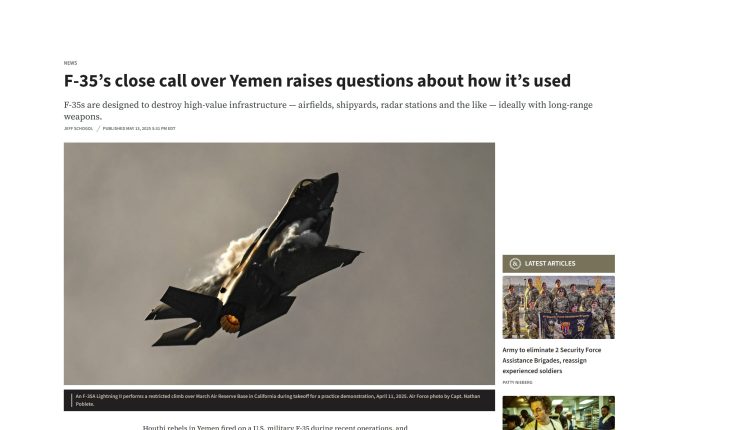US official: “Yemeni missile came close enough to F-35 for pilot to evade”
A US official confirmed to Task & Purpose that “Houthis in Yemen fired on a US military F-35 during recent operations, and that the missile came close enough to the aircraft for the pilot to evade.” The official noted that the incident was first reported in The New York Times as part of a story about why President Donald Trump decided to end air and missile strikes against the Houthis earlier this month.
He noted that no additional information was immediately available regarding how close the F-35 came to Houthi air defenses.
Dan Grazier, a senior fellow and director of the National Security Reform Program at the Stimson Center, a think tank in Washington, D.C., stated that it would be an “absolute disaster” if the U.S. military lost one of its advanced and expensive F-35s to the Houthis.
Grazer told Task & Purpose magazine: “The reason the American people sacrificed hundreds of billions of dollars on this program is that this was supposed to be the fighter of the future. It was supposed to be able to counter accelerating threats and penetrate heavily defended airspace. If one of them was shot down by a non-state actor, it would debunk all claims about the F-35’s superior capabilities.”
The website explained that, “Even after years of development, the F-35 still has very limited combat capabilities,” according to Grazier. The aircraft requires upgrades to its computing power and software to operate most of its weapons, but that process could take until the end of the decade. He said that given the current state of the F-35, the Houthis’ targeting of it “is a bit surprising, but certainly not shocking.”
Grazier said, “If it can’t survive this level of combat, a reasonable person wouldn’t be unjustified in questioning whether it can survive a more intense form of combat, which is precisely why the American people are paying a premium for the design and construction of the F-35.”
Richard Aboulafia, managing director of aerospace consultancy Aerodynamics, told Task & Purpose rhzgh: “If the Houthis had been able to shoot down an F-35, it would be indicative of shortcomings in the military operation, not the aircraft itself.” He noted that between 2015 and 2022, the Saudi-led coalition launched airstrikes in Yemen and learned that the Houthis had very formidable air defenses.
Aboulafia said that the F-35’s mission in the event of a war with China would be to “open the door” by destroying advanced air defense systems and other high-value targets—preferably with long-range weapons—before they are detected.
Over more than two decades, F-35 costs have skyrocketed, while the program has faced numerous delays. By the spring of last year, the entire U.S. military had approximately 630 F-35s, according to a Government Accountability Office report released in April 2024.
The F-35A, used by the U.S. Air Force, costs $82.5 million per aircraft; the F-35B—a short takeoff and vertical landing aircraft used by the Marine Corps—costs $109 million per aircraft; and the F-35C, used by both the Navy and Marine Corps for aircraft carrier operations, costs $102.1 million per aircraft, according to the F-35 Joint Program Office.
The entire F-35 program is estimated to cost approximately $2.1 trillion over its 94-year lifespan, from 1994 to 2088. This includes all development, production, and maintenance costs for the F-35, including the construction and modernization of 2,456 aircraft by 2049, the Joint Program Office announced in April.
Meanwhile, the U.S. Air Force’s version of the aircraft continues to face reliability issues. Between 2021 and 2024, the F-35A’s mission performance rate—the number of times it completed at least one mission—declined from approximately 69% to 51.5%, according to Air Force Times.

